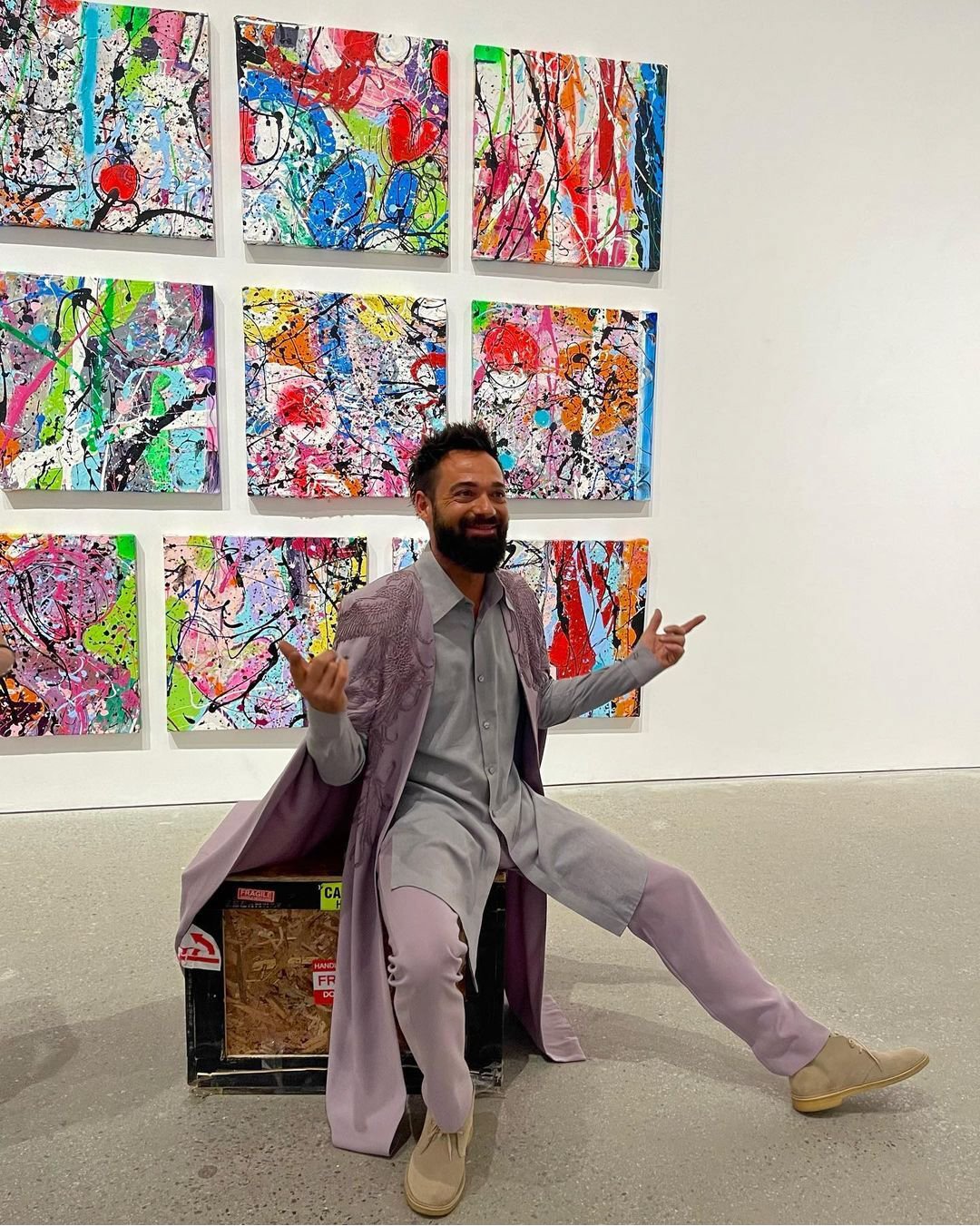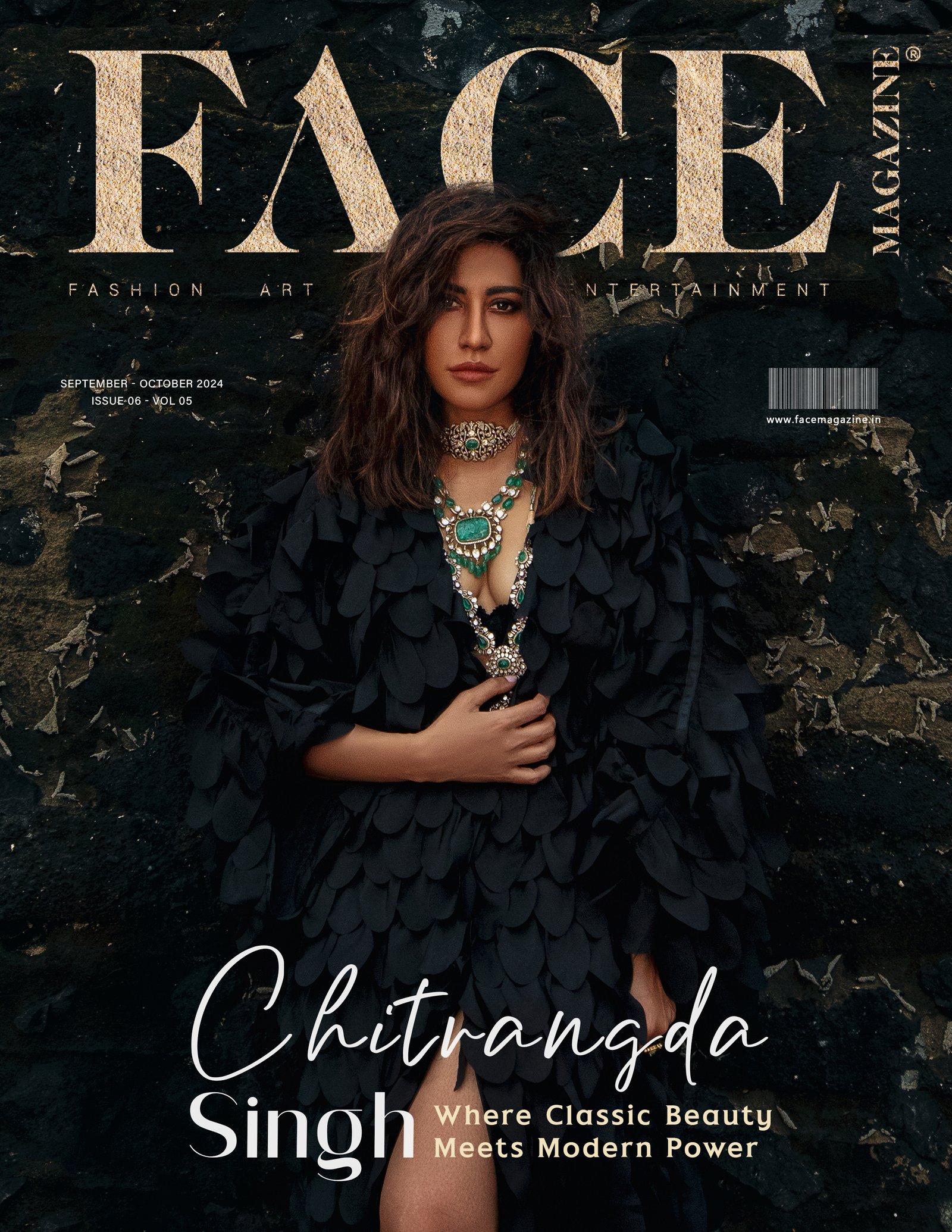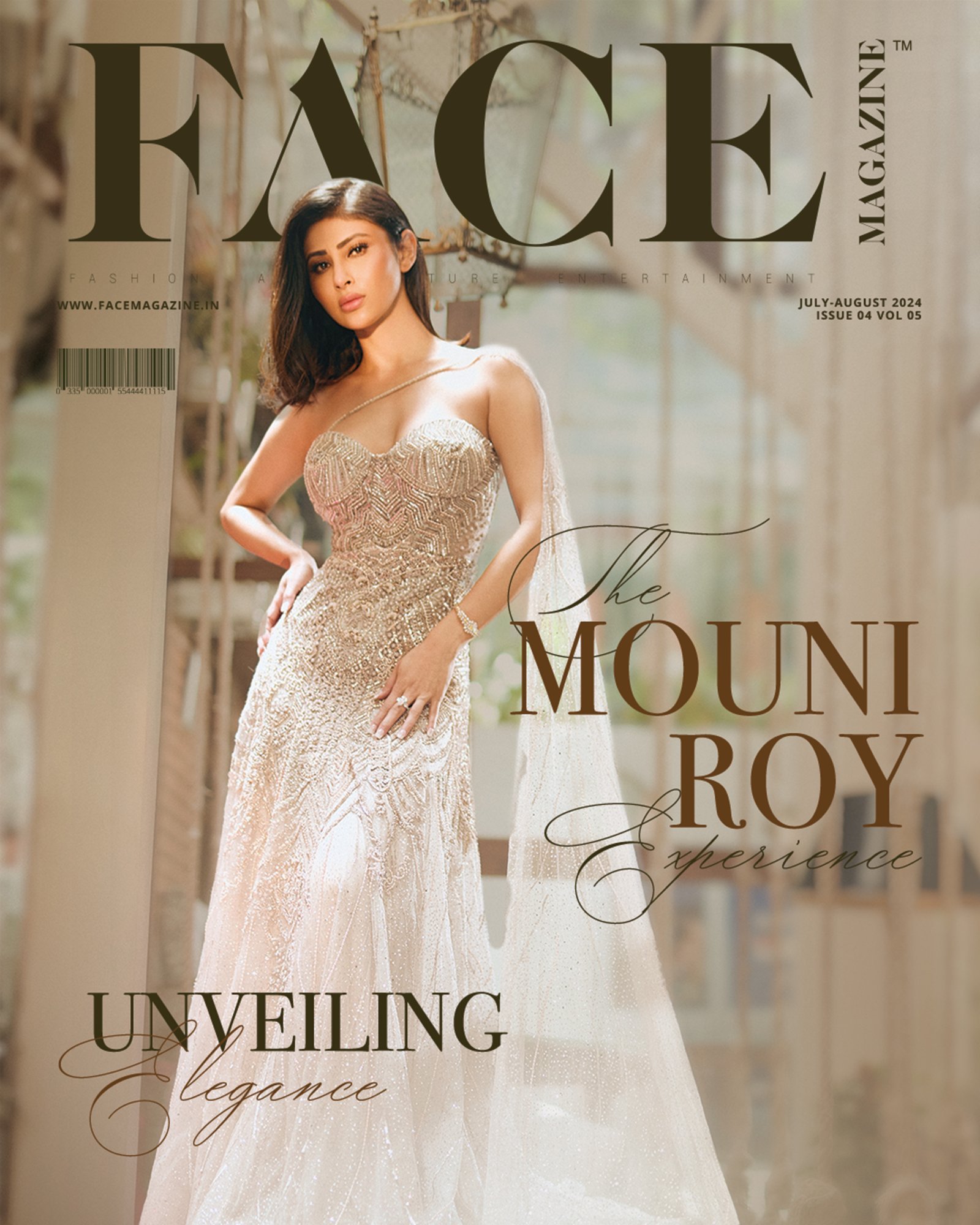Interviewed by Madhuri Bhaduri @artistmadhuribhaduri Art Director – Face magazine

Sacha Jafri (born 1977 in the United Kingdom) is a contemporary British artist known for creating the world’s largest painting on canvas “Journey of Humanity”, as recognized by the Guinness Book of World Records over seven months during the COVID-19 pandemic in Dubai. The work was sold at auction in Dubai for 228 million Dirham $62 million US making it the fourth-highest price ever paid for a work of art by a living artist, behind Jeff Koons (Rabbit $91.1 million US), David Hockney (“Portrait of an Artist (Pool with Two Figures)” $90 million US), and Beeple (“Every day: the First 5000 Days” $69.3 US), respectively,
The painting measuring over 17,000 square feet and incorporating the artwork of children from more than 140 nations artwork was purchased by French crypto businessman Andre Abdoune. Jafri is donating the proceeds from the sale to children’s charities. Jafri generally works outside the art gallery system, donates many of his works and or proceeds from them to charity efforts, and numbers among his collectors Barack Obama, members of the British royal family, Sir Richard Branson, Paul McCartney, Leonardo DiCaprio, Bill Gates, Madonna, David Beckham, George Clooney, and Eva Longoria. Jafri attended Eton College. In 2000 he obtained his master’s degree in Fine Arts from Oxford University.
Prince Charles commissioned Jafri to do portraits of the “14 most influential living Muslims” for his Mosaic initiative. He has also been appointed a resident artist by the 21st Century leader’s charity. In 2014 he created the cover art for “Silver Rails” the final studio album made by the musician Jack Bruce.

1: Hi Sacha, it’s a pleasure getting to speak to you. So what I would like to ask you first is that could you take us back to the start of your journey?
I have been painting for 25 years, so all I can tell you is probably the significant parts of my journey at this point. Back in my school days I was heavily dyslexic, and about 15-16 years old I was in a school in England with Prince William and it was really academic, and I realized that I couldn’t make sense of anything in the world. So the only thing that actually did make sense to me was ‘painting’. I found that painting was the one thing that drew my attention, made sense of the world for me and what existence meant for me. It felt like it was my purpose. I was lucky enough I got into art school through the YBA and what I learned in art school was that I was very much a painter and I loved to draw so I guess what I learned to draw is to learn to see. And to learn to see is really difficult. So what Oxford really taught me was basically that when we were in school we studied ciphers and the different molecular structures of men and women and humans, different bone structures, different muscle structures, etc. I think when u see the inside of the body this clearly, u see the outer surface very differently and how it all connects and it was very knowledgeable. I also learned one very important thing, that as an artist what people really focus on is the finished product. What the art world really has turned into is about is only related to selling the art. According to my people already have figured out what they’re going to do with the art and where they’re going to sell it or who they’re going to sell it to. And I think there’s a big problem with that because for me the most important thing is the journey and the process. As an artist, it doesn’t matter what you create, it only matters if u live with grace and love, and what will happen is that every now and then you will have a moment, you will in fact borrow that moment and you will say thank you, you will create some magic and then you will give that moment back and then say a thank you for that moment and it will be amazing. So what I think I learned through my art journey is that, no matter how beautiful a thing you create as an artist, it doesn’t hold much value or meaning unless you live your life in grace and humility and always give back.
2: What was the pivotal moment in your journey as an artist, that changed something about you?
So there are a lot of those moments that I’ve been inspired not by artists but by humanitarians, filmmakers, and writers. The great Gabrielle Garcia Marquez, Paulo Coelho, Rahid Mistry have been one of my most favorite writers. Filmmaker’s like Tim Burton, Stan lee Cooper; all created this magical world that made you explore your dreams through their creative films. I try with my work to almost act like an electric shock to the senses of the viewer, and try to awaken the child inside them. What was pivotal to me in my journey was that I realized that as people and as an artist, I always wanted to keep the child in me alive and I think that is our essence. So through my work, I try to enable that child in my viewers and almost make them go on this journey again to make the adult in them remember their essence.
The 2 big moments for me in my journey that changed a lot for me and helped me not only as an artist but as a person too were when I was working with Mr.Nelson Mandela in South Africa. I was working for his children’s foundation there and he taught me 3 things that have stuck with me throughout my journey.
– First thing he taught me was that from the darkness comes the light. That is something that if u really think about, it teaches you a lot as a person and how from the darkness & from the difficult moments is when you make it through and let your light shine and something beautiful comes out of it.
– Second thing and one of the most important things he taught me was that we as humans have become so self-important that we forget that we’re just a spec in the universe. And the difference we make is only to ourselves and everything around us.
– The third thing is that, when he was incarcerated for 24 years, he always said a poem and remembered it through his time there and that helped him through it-
– “I am the master of my fate and I am the captain of my soul” it taught me so much about universal consciousness- we are all one and we are all connected. That we are made of energy, we connect through it.
When Covid-19 hit us, humanity was in a bad shape. The world became so agenda-filled energy through these times. There was more money in litigation spent in 2018-19 than in the past two decades. Honesty and good intentions were gone and manipulation to get your way through became the thing to do and I am someone who doesn’t agree with that. But what also happened was that covid-19 has given us the ability to reconnect at the same time- becoming less full of ourselves and more about bettering the world and being together through these difficult times. This is also one of the reasons I created my journey of humanity; to create and inspire change.
3: I see your energy in your work, the vibrant colors of your personality show on your canvas. So what my next question would be to you is how important do u think the energy of an artist is?
I don’t see it as my energy, I see my art as pouring a moment. The most important thing as an artist for me at least is to surrender completely. We as people always try to calculate and manipulate the outcome and what it might turn out to be. I would rather not do that. I, have always believed in something intangible, for example, this project- THE JOURNEY OF HUMANITY, I had faith in the universe and I decided to just surrender and tap into something greater than me and life itself, and then what happens will happen. The thing with me is that I paint in a deep trance, almost a meditative state. Actually, there was a test done on me, where they put pads on my head to test my brain theta when I paint. It was a place of meditation, which tapped deep into my subconscious. So what my brain would follow and every brain theta follows is colors and shapes and all these things that came after- mountains, women and men, children, etc. So all of this comes from the subconscious part of my and everybody’s brain. What you see right now on my canvas, I don’t think it’s my energy, it’s more about how I choose to live my life and that shows on my canvas. Meeting people, helping people that are less fortunate, helping children, it all shows in my work. My energy as a person is who I am. I’ve spent the past 25 years of my life dedicated to the journey of humanity and I think that is more my work than the energy I put on my canvas.
4: What I would like to ask you next is a little bit of a technical question, what everybody would like to know is about the journey of humanity, the dimensions, the length, how long did it take u to complete and how did u manage to actually get it on such a big canvas?
The painting itself ranges at about 20,000 sq. ft. I used about 1000 brushes and 1400 gallons of paint. I painted for about 20 hours a day. I had two operations during those 8 months of painting ‘The journey of humanity’. Two vertebras came out of my spine, my pelvis was messed up, and in fact, they had to put a rod in my spine. The painting itself was rolled out on the floor and it took about 5 months after finishing the painting, to cut the painting and stretch it which was 15 months of the whole process. At times I thought I should give up as it was taking so much out of me, I was in a wheelchair. I was taking pain injections for my hip every 4 hours. I was working on about 3-4 hours of sleep every day. It felt like I was running a marathon every day during the whole process of the painting. The brushes I used were only 1-1.5 inches which are usually used for a 1×1 ft. canvas. The biggest brush I used was 2 inches. So there were no rollers, nothing. The painting was 2000 sq. meters, almost the size of two football pitches. You can’t even hang it up to paint it. It was on the floor. That’s how I was painting, on my wheelchair with a canvas on the floor.
5: What do you think is an artist’s role in society? How important is it?
There’s enough stuff in this world that makes us think and work. I think art has one job which is to uplift and inspire the soul. I think the true meaning of art got lost along the way. The main role of art and an artist is to disengage the brain and engage the soul, to motivate a person to feel good about what the world has to offer, the intricate detail of every stroke, of every form of art, is to inspire a sort of journey in the viewer. I realized that we as people need to unlearn everything we’ve ever learned and relearn the world and life through our children. From that unlearning and learning and the journey as a humanitarian, something beautiful will happen and does happen and that shows on your canvas and in your art and I think that is very important for us as a society.
6: What is your comment about art fairs as such that happen today?
Art fairs today are getting bigger and bigger as projects and are throughout different countries that are helping artists all over the world who don’t have enough exposure, come to light and show their work by giving them a platform. It is a great place to share your work and ideas, great publications that are a part of these art fairs, the art critiques, the curators, all become a part of this and in fact, are as important as an artist. It creates a great ecosystem of the curator, the writer, the artist, the viewer, and the collector. It also enables the collector base to grow. I don’t personally love showing in art fairs, I’d rather do an exhibition. The thing about art fairs is that they have this way of showing art; white walls, lighting, one art piece next to another. It takes away from the experience of the art. Doesn’t feel like how it should be shared with people. If I had to organize it myself, I would prefer to have an exhibition with about 8 pieces in a darker environment and lighter something that would completely engage the viewer which would take them into a space dedicated to the energy of the artist. It’s hard to achieve that in an art fair. I would have an art fair very differently where I would create a more atmospheric experience, lesser artists even and show the work in a unique way where it’s more personalized to the artist. Having different rooms for everybody’s work where the art has its own space and a way of being shared with the public. So basically less like a jumbo sale, more like sharing the art.
7: Don’t you think the journey of the artist is alone? That it’s a soul’s of the journey of a person?
I don’t work with galleries. I mean I do but I don’t do contracts, so I only have my solo exhibitions most often. My journey is a humanitarian one, and all these contracts and stagnant places tie you down as a person which I don’t believe in. A lot of these things are scheduled, fixed, and everybody is very financially driven- I’m not. I see money as something that buys me time and that’s it. I give away 90% of what I earn to different charities all over the world. And obviously, a gallery doesn’t like that. So I guess most of my journey is alone in one way or another since how I think and what I believe in is how I choose to live my life and use my work.
8: One last thing I would like to ask you is that what is your message to the younger generation today?
I think my message to everybody, not just the younger generation would be that live your life with grace and humility, channel yourself and your energy in making your spiritual journey as a person and be the most beautiful human that one can be and over time your life and your life’s purpose will come to you and be fulfilled sooner or later.
For more updates follow: Sacha Jafri







